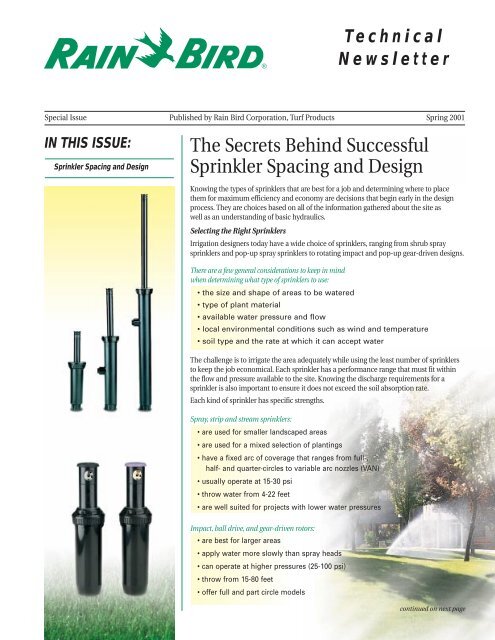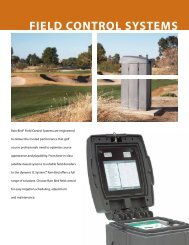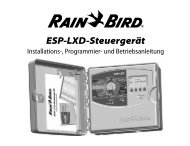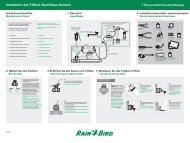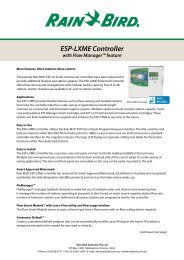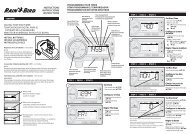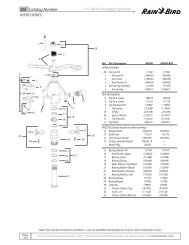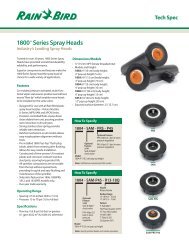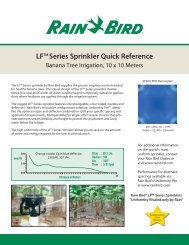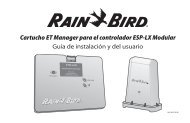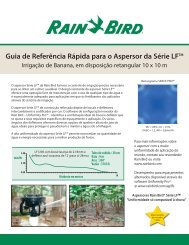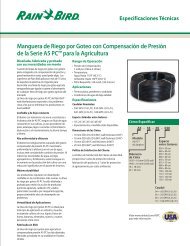Sprinkler Spacing and Design - Rain Bird
Sprinkler Spacing and Design - Rain Bird
Sprinkler Spacing and Design - Rain Bird
You also want an ePaper? Increase the reach of your titles
YUMPU automatically turns print PDFs into web optimized ePapers that Google loves.
T echnical<br />
Newsletter<br />
Special Issue Published by <strong>Rain</strong> <strong>Bird</strong> Corporation, Turf Products Spring 2001<br />
IN THIS ISSUE:<br />
<strong>Sprinkler</strong> <strong>Spacing</strong> <strong>and</strong> <strong>Design</strong><br />
The Secrets Behind Successful<br />
<strong>Sprinkler</strong> <strong>Spacing</strong> <strong>and</strong> <strong>Design</strong><br />
Knowing the types of sprinklers that are best for a job <strong>and</strong> determining where to place<br />
them for maximum efficiency <strong>and</strong> economy are decisions that begin early in the design<br />
process. They are choices based on all of the information gathered about the site as<br />
well as an underst<strong>and</strong>ing of basic hydraulics.<br />
Selecting the Right <strong>Sprinkler</strong>s<br />
Irrigation designers today have a wide choice of sprinklers, ranging from shrub spray<br />
sprinklers <strong>and</strong> pop-up spray sprinklers to rotating impact <strong>and</strong> pop-up gear-driven designs.<br />
There are a few general considerations to keep in mind<br />
when determining what type of sprinklers to use:<br />
• the size <strong>and</strong> shape of areas to be watered<br />
• type of plant material<br />
• available water pressure <strong>and</strong> flow<br />
• local environmental conditions such as wind <strong>and</strong> temperature<br />
• soil type <strong>and</strong> the rate at which it can accept water<br />
The challenge is to irrigate the area adequately while using the least number of sprinklers<br />
to keep the job economical. Each sprinkler has a performance range that must fit within<br />
the flow <strong>and</strong> pressure available to the site. Knowing the discharge requirements for a<br />
sprinkler is also important to ensure it does not exceed the soil absorption rate.<br />
Each kind of sprinkler has specific strengths.<br />
Spray, strip <strong>and</strong> stream sprinklers:<br />
• are used for smaller l<strong>and</strong>scaped areas<br />
• are used for a mixed selection of plantings<br />
• have a fixed arc of coverage that ranges from full-,<br />
half- <strong>and</strong> quarter-circles to variable arc nozzles (VAN)<br />
• usually operate at 15-30 psi<br />
• throw water from 4-22 feet<br />
• are well suited for projects with lower water pressures<br />
Impact, ball drive, <strong>and</strong> gear-driven rotors:<br />
• are best for larger areas<br />
• apply water more slowly than spray heads<br />
• can operate at higher pressures (25-100 psi)<br />
• throw from 15-80 feet<br />
• offer full <strong>and</strong> part circle models<br />
continued on next page
continued from front<br />
<strong>Sprinkler</strong> performance charts from the<br />
manufacturer can summarize critical<br />
information to help designers make the<br />
best sprinkler decisions. (see figure 1)<br />
SPRINKLER SPACING AND RANGES<br />
12 SERIES (STANDARD 30° TRAJECTORY)<br />
Nozzle Pressure Radius Flow Precip. Precip.<br />
psi ft. GPM in/h in/h<br />
15 9 1.80 2.14 2.47<br />
20 10 2.10 2.02 2.34<br />
25 11 2.40 1.91 2.21<br />
12F 30 12 2.60 1.74 2.01<br />
15 9 0.90 2.14 2.47<br />
20 10 1.05 2.02 2.34<br />
25 11 1.20 1.91 2.21<br />
12H 30 12 1.30 1.74 2.01<br />
15 9 0.45 2.14 2.47<br />
20 10 0.53 2.02 2.34<br />
25 11 0.60 1.91 2.21<br />
12Q<br />
figure 1<br />
30 12 0.65 1.74 2.01<br />
Spray heads <strong>and</strong> rotors each have different<br />
requirements for zoning <strong>and</strong> spacing.<br />
<strong>Spacing</strong> <strong>Sprinkler</strong>s<br />
Efficient spacing begins with an underst<strong>and</strong>ing<br />
of sprinkler water distribution.<br />
<strong>Sprinkler</strong>s are designed for overlapping<br />
coverage. Proper overlap ensures even<br />
distribution of water <strong>and</strong> eliminates dry<br />
spots. When overlapped, the weak area<br />
of coverage from one sprinkler is supplemented<br />
by the surrounding sprinklers.<br />
Head-to-head spacing, or sprinklers<br />
spaced at 50% of the sprinkler’s diameter,<br />
is most common to ensure uniform<br />
coverage. (see figure 2)<br />
Determining <strong>Sprinkler</strong><br />
Precipitation Rates<br />
The designer needs to know how much<br />
water is needed per week or per day<br />
to maintain the turf <strong>and</strong> how that<br />
compares to the amount of water the<br />
sprinklers in an area will apply. The<br />
precipitation rate (PR) is the calculated<br />
average amount of water that all of the<br />
sprinklers in a specific area apply in one<br />
hour. It is usually measured in inches per<br />
hour (metric=mm/h). This delivery rate is<br />
based on the type of nozzle, the arc <strong>and</strong><br />
the spacing.<br />
Calculating the PR early in the process<br />
helps the designer make sure that the<br />
sprinklers can apply enough water<br />
during the time available for watering<br />
(water window), without exceeding the<br />
soil intake rate.<br />
Here is the formula:<br />
PR Formula<br />
PR = 96.3 x gpm (applied to the area) = IN/HR<br />
S x L (or area in ft 2 of each zone)<br />
96.3 – is a constant<br />
GPM – applied to target area by all sprinklers<br />
in pattern<br />
S – distance in feet of sprinklers on a row<br />
L – distance in feet between sprinkler rows<br />
IN/HR – average inches per hour<br />
Matched Precipitation Rates<br />
Matched precipitation rate (MPR) refers<br />
to sprinklers that apply water at the same<br />
rate per hour no matter the arc of coverage<br />
or part of a circle they cover. For<br />
instance, a full-circle sprinkler discharges<br />
twice the flow of a half-circle sprinkler <strong>and</strong><br />
a quarter-circle sprinkler discharges half<br />
of what the half-circle unit does.<br />
MPR allows the same type of sprinklers,<br />
no matter what their arc, to be circuited<br />
on the same valve <strong>and</strong> to deliver the same<br />
PR rate. Spray heads have fixed arcs <strong>and</strong><br />
are matched by the manufacturer, while<br />
rotors offer a choice of nozzles to match<br />
the designed arc pattern. (See figure 3)<br />
Example of MPR sprinklers.<br />
figure 3<br />
Practice calculating the PR for this area.<br />
The spacing, length <strong>and</strong> gpm discharge<br />
for the full-, half- <strong>and</strong> quarter-circle<br />
sprinklers are shown on the layout.<br />
The operating pressure is 25 psi (2 bars)<br />
<strong>and</strong> radius of throw is 11 feet (3.3528 m).<br />
The total number of gallons applied by<br />
these MPR sprinklers is:<br />
• 1 - Full-circle sprinkler = 2.40 gpm (0,16 l/s)<br />
• 4 - Half-circle sprinklers = 4.80 gpm (0,32 l/s)<br />
• 4 - Quarter-circle sprinklers = 2.40 gpm (0,16 l/s)<br />
A total of 9.6 gpm is applied to the area.<br />
To calculate the PR for this area:<br />
PR = 96.3 x 9.6 gpm = 924.48 = 1.75 in/hr<br />
22 X 24 = 528<br />
The PR is 1.75 inches per hour (44.5 mm/hr).<br />
Zoning <strong>and</strong> Rotor <strong>Spacing</strong><br />
To avoid overwatering, designers should<br />
never combine sprinklers in the same<br />
valve group if the sprinkler precipitation<br />
rates are not matched (or have more than<br />
a 10% difference). Also avoid grouping<br />
sprinklers that are at different elevations.<br />
For a rough estimate of the number of valve<br />
zones needed, add the gpms (liters/sec)<br />
for all sprinklers <strong>and</strong> divide the total by<br />
the maximum gpms (liters/sec) available<br />
from the water source.
Keeping the Rotor Ratio Correct<br />
If spray heads are spaced correctly,<br />
whether half-, quarter- or full-circle heads<br />
are used, the designer can achieve MPR.<br />
The same can be accomplished with<br />
rotors, but the designer must choose<br />
nozzles to keep the quarter-circles,<br />
half-circles <strong>and</strong> full-circles at a ratio<br />
of one to two to four. (see figure 4)<br />
figure 4<br />
Here is an example of the 1 to 2 to 4 ratio.<br />
All half circles are at 4 GPM <strong>and</strong> all<br />
quarter circles are at 2 GPM.<br />
figure 5<br />
By changing the nozzle sizes on zone 2, we<br />
can obtain proper coverage <strong>and</strong> complete this<br />
design using only 3 circuits, or zones. Here is<br />
an example of the 1 to 2 to 4 ratio zoned <strong>and</strong><br />
nozzled to h<strong>and</strong>le existing flow conditions.<br />
Just remember, designers may have<br />
to make adjustments to deal with<br />
real-world situations. To keep the<br />
application rate matched with rotors,<br />
the designer has to look at the nozzles<br />
<strong>and</strong> spacing. For instance, in figure 4, if<br />
the available flow is 10 gpm, the top row<br />
of sprinklers could form one zone at 8<br />
gpm, as could the bottom row. But the<br />
middle row would exceed the flow<br />
available. The designer could renozzle<br />
the half-circles to 2 gpm <strong>and</strong> the<br />
full-circle to 4 gpm in the middle row,<br />
which would still keep the 1-2-4 ratio<br />
within that zone. However, the run<br />
time must then be doubled for zone 2<br />
compared to zones 1 <strong>and</strong> 3 because it<br />
is covering twice the area with the same<br />
flow rate. (see figure 5)<br />
Caution! Check to make sure going to<br />
the smaller nozzle will still provide the<br />
desired radius <strong>and</strong> coverage.<br />
Checking Total System Operating<br />
Time to Ensure Success<br />
In addition to following the appropriate<br />
spacing <strong>and</strong> zoning principles, designers<br />
should be sure to stop on a regular basis<br />
throughout the design to check the total<br />
system operating time. This should not<br />
exceed the daily time period available for<br />
irrigation known as the water window<br />
(i.e. 10 p.m. - 6 a.m.). To meet the water<br />
window requirements, the available<br />
system flow may need to be increased.<br />
24'<br />
(7.3m)<br />
figure 6<br />
12 Q<br />
12 H<br />
12 H<br />
12 H<br />
12 F<br />
12 Q 12 Q<br />
24'<br />
(7.3m)<br />
12 Q<br />
12 H<br />
12'<br />
(3.7m)<br />
12'<br />
(3.7m)<br />
50'<br />
(15.2m)<br />
15 EST<br />
4'<br />
(1.2m)<br />
figure 7<br />
12.5' 35'<br />
(10.67m) (3.8m)<br />
12.5' 35'<br />
(10.67m) (3.8m)<br />
15 SST<br />
15 SST<br />
12.5' 35'<br />
5004-PC 5004-P<br />
(10.67m) (3.8m) 6.0 GPM (22. (22.8 l/min)<br />
Half Circ Circle<br />
15 SST<br />
12.5' 35'<br />
(10.67m) (3.8m)<br />
15 EST
figure 8<br />
200'<br />
(61.0m)<br />
15 Q<br />
15'<br />
(4.6m)<br />
50'<br />
(15.3m)<br />
50'<br />
(15.3m)<br />
50'<br />
(15.3m)<br />
50'<br />
(15.3m)<br />
15 H<br />
3504<br />
SERIES<br />
ROTORS<br />
figure 11<br />
15'<br />
(4.6m)<br />
50'<br />
(15.3m)<br />
15 H<br />
60'<br />
(18.3m)<br />
3504<br />
1 GPM<br />
(3.8 l/min)<br />
15'<br />
(4.6m)<br />
6504<br />
Half<br />
15 H<br />
6504 Full<br />
6504 Full<br />
6504 Full<br />
6504<br />
Half<br />
100'<br />
(30.5m)<br />
15 Q<br />
15'<br />
(4.6m)<br />
figure 9<br />
20'<br />
(6.1m)<br />
50'<br />
(15.3m)<br />
15'<br />
(4.6m)<br />
3504<br />
2 GPM<br />
(7.6 (7.6 l/min)<br />
l/min)<br />
7005 6504<br />
Quarter<br />
6504<br />
Half<br />
6504<br />
Half<br />
6504<br />
Half<br />
6504 7005 6504<br />
Quarter<br />
20'<br />
(6.1m)<br />
60'<br />
(18.3m)<br />
1804<br />
SERIES<br />
SPRAY<br />
HEADS<br />
3504<br />
2 GPM<br />
(7.6 (7.6 l/min)<br />
l/min)<br />
Here are some possible solutions of sprinkler head layouts.<br />
3504<br />
1 GPM 20' GPM (6.1m)<br />
(3.8 (3.8 l/min)<br />
l/min)<br />
20'<br />
(6.1m)<br />
6504 SERIES ROTORS<br />
7005 SERIES ROTORS<br />
5004<br />
SERIES<br />
ROTORS<br />
260'<br />
(79.2m)<br />
65'<br />
(19.8m) (17.5m)<br />
65'<br />
(19.8m) (17.5m)<br />
65'<br />
(19.8m) (17.5m)<br />
65'<br />
(19.8m) (17.5m)<br />
figure 10<br />
5004-PC<br />
3.0 3.0 GPM GPM (11.4 l/min)<br />
Quarter Circle<br />
65'<br />
(19.8m) (17.5m)<br />
35'<br />
(10.67m)<br />
5004-PC<br />
6.0 6.0 GPM GPM (22.8 l/min)<br />
Half Circle<br />
7005<br />
Half<br />
70'<br />
(21.34m)<br />
7005 Full<br />
7005 Full<br />
7005 Full<br />
7005<br />
Half<br />
130'<br />
(39.6m)<br />
35'<br />
(10.67m)<br />
5004-PC<br />
3.0 3.0 GPM GPM (11.4 l/min)<br />
Quarter Circle<br />
65'<br />
(19.8m) (17.5m)<br />
7005<br />
7005<br />
Quarter Quarter<br />
Quarter<br />
7005<br />
Half<br />
35'<br />
(10.67m)<br />
7005<br />
Half<br />
7005<br />
Half<br />
7005<br />
Quarter<br />
figure 12


